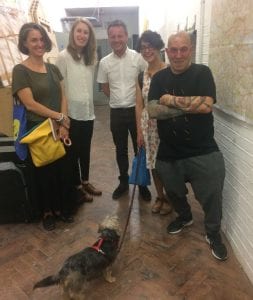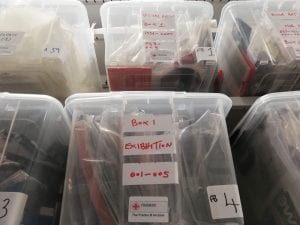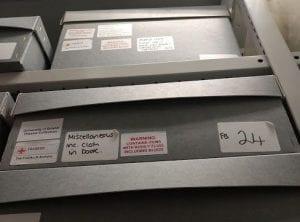As part of the Wellcome Trust funded project Challenging Archives: Delivering research access, public engagement and the curatorial care of the Franko B archive, writers-in-residence, Mary Paterson and Maddy Costa are engaging creatively with the Franko B archive as it is catalogued, conserved and made accessible. This is the first in a series of blog posts that will reflect on the complex set of challenges the Franko B archive poses, the archival process and Franko B’s artistic practice which explores issues such as the limits of the body and the human condition, dealing with pain, suffering, abuse of power, empathy, eroticism, and sexuality in contemporary culture. In navigating these issues there may be references which some readers find upsetting.

Throughout their residency, Maddy and Mary will be writing in dialogue: sometimes addressing correspondence directly to each other, sometimes, as here, presenting the text unattributed.
Part 1
What is the body of the archive? Where is the body of the archive? Where is it felt? Where does it sag? Where does it leave its mark? Where does it leave its traces? Who traces it? Who traces it with her finger, choosing between its pages, hesitating beneath a word?
Where do you hesitate when you’re looking at another body? I mean, someone else’s body? I mean someone else’s body of work, which does not exist in material but in memory? Is there a difference between a body and a memory? How is it felt, this difference? Where is it held, this difference? Where do you hold your memories? How do you hold your body? How do you remember bodies you have never held? What is there to hold on to?
What is there to hold onto from the past? From yesterday, or the day before, or the un-photographed moments in the days before that? What can you touch, and what touches you? What touches you like a handshake or a brush of the hair or a drop of something warm and sticky and hard to keep a hold of? I mean, what is touching in a memory? What is physical about it? What is a physical memory – like a mould, or a fingerprint or a photograph; and what is physical about memory – like the imprint it leaves on your muscles, the feeling it pierces into your skin?
And now?
Do you think there is something made (up) in the acts of preservation?
Do you think about the possibilities, the potential meetings, the speculative meanings, the retrospective knowledge, the collaborative documents, the modern memories, the new histories, the re-readings that are created from the acts of preservation? What is made with this care, this consideration, this meta data, this record keeping, this safe pair of hands? How does it feel to handle someone else’s memories? What does it mean to make available someone else’s life, their work, their life’s work? When it comes to someone else’s life’s work, what is available? What is available and what is always unavailable? What is always unavailable but can be imagined: summoned up in the space between photographs and flyers and a drop of something that was once contained within a body?
How do you preserve this feeling, wrap it up in acid-free packaging and keep it safe?
What is safe?
What is safe-keeping?
What is being safe and what is keeping?
What is lost? What is a challenge? What is challenging about safety, about memory, about preservation? I mean, what is a challenge to keep safe? And what is it about this material, this body, this bodily material, that is a challenge?
What is a challenging body (of material)?
What is a threatening body (of material)?
What are the threats of the body (of the archive)?
What are the threats to the body (of the archive)?
How can a body (of work) be a threat, and how can it be a possibility?
How do you find its possibilities? How do you trace them with your eyes, your fingers, your memory? How do you encounter them? How do you start the encounter, how does it take shape, and who makes the shape (in)visible? Does it make sense to call the shape of this encounter alive? Is it a life? Is it a living thing? Is it a dangerous thing? Is it possible to have a dangerous encounter with a body of work that is being held for safe-keeping?
What kind of future are we saving (ourselves) for?

Part 2
I am thinking about Franko’s body. The tattooes that clamber across his face and tuck themselves beneath his clothes, hidden, alongside the scars. I’m thinking of the needles that pricked his skin to create those tattooes, the scalpels that sliced through epidermis, dermis, maybe reaching hypodermis too, in his willingness to let the violence of the world imprint itself visibly on his body. I’m thinking about the hidden scars of a body that grew in difficult and inhospitable environments: an orphanage run by priests, an aggressive family home, a Red Cross boarding institition where some staff were kind and some were bullies. Scars that trace the nervous system, felt inside the body as an electric pulse.
I am thinking about the warmth of Franko’s body. The warmth of his voice when he speaks, the purr of it, a cat demanding attention, the burr of it, the pronunciation of English words catching on his Italian accent. A resonance at once high and low, the treble of energy, excitement, indignation, the bass of sensuality, viscerality, self-possession.
I am thinking about the charm that is held inside that body. The charm of Franko the storyteller as each photograph in the archive prompts a reminiscence, a story. The charm of the conjuror playing games with time, so that when we speak it is at once now and then, the time of the archive, the document, the record, and the time of the work being made and performed or presented. The charm of the politically motivated and marginalised, of the activist who doesn’t want your approval but knows it will come eventually because he is right.
I am thinking about the history that is held inside that body. The history of social services and care provision for children. The history of mental health diagnoses. The history of homophobia. The history of right-wing politics. The history of authoritarian abuse. None of these things are history, and not just because their scars trace the nervous system inside the body. Each one is still a scalpel, slicing through the skin of culture to the person beneath.
I am thinking about Franko’s body as it is contained inside two of the temporary boxes in the archive. One of the boxes is made of grey cardboard and carries a sticker with the words “Warning: contains items with bodily fluid, including blood” printed on it in bright red ink. One of the boxes is plastic and carries a sticker with the single word “Exibhition” hand-written in bright red marker pen. I am thinking about how the warning sticker pushes me away, gives rise to a feeling of anxiety. How the hand-written sticker with its jumbled spelling pulls me close, gives away something about vulnerability that inspires a feeling of care. And yet the box that carries the warning, holding blood and skin cells, traces of DNA, might bring me closer to Franko’s actual body. While the box that carries the exibhition sign holds only images, distance, remove.
I am thinking about the difference between meeting a body in person and meeting them through images and words. For years now I have “known” Franko through images and words: photographs of him performing, word-of-mouth description, critical appraisals of his work. I haven’t known his work myself because I felt anxious about the warning signs, the bodily fluids, the blood. And so I’m thinking about the assumptions that attach themselves to words and images, which might have nothing to do with their subject, the person or body, and everything to do with the gaze and understanding of the audience.
I am thinking about us, as the audience of this archive. What are we listening for, as we look? Do we need Franko present to tell us his stories, or can we read those stories into the archive ourselves? What difference does it make that you have encountered his work in person, seen the blood as it drips bright red from his body to the canvas, and I see only the canvas stained with his dried brown blood? What is, as a result, visible to you that might be invisible to me? What is, as a result, audible to you that might be inaudible to me?
I am thinking about entering the archive as an act of unfolding, each discovery opening up a new possibility, a new question. I am thinking about thinking, the complexity of thought that goes into any single action, the movement of thought through blood and bodily fluid, unseen, but making action possible.

